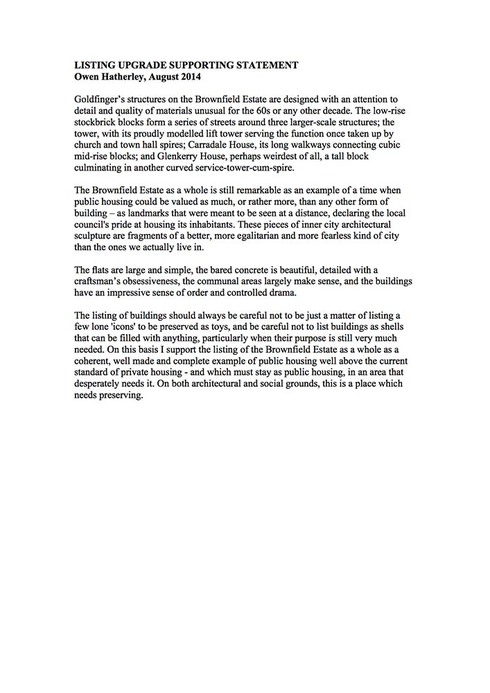
Goldfinger’s structures on the Brownfield Estate are designed with an attention to detail and quality of materials unusual for the 60s or any other decade. The low-rise stockbrick blocks form a series of streets around three larger-scale structures; the tower, with its proudly modelled lift tower serving the function once taken up by church and town hall spires; Carradale House, its long walkways connecting cubic mid-rise blocks; and Glenkerry House, perhaps weirdest of all, a tall block culminating in another curved service-tower-cum-spire.
The Brownfield Estate as a whole is still remarkable as an example of a time when public housing could be valued as much, or rather more, than any other form of building – as landmarks that were meant to be seen at a distance, declaring the local council's pride at housing its inhabitants. These pieces of inner city architectural sculpture are fragments of a better, more egalitarian and more fearless kind of city than the ones we actually live in.
The flats are large and simple, the bared concrete is beautiful, detailed with a craftsman’s obsessiveness, the communal areas largely make sense, and the buildings have an impressive sense of order and controlled drama.
The listing of buildings should always be careful not to be just a matter of listing a few lone 'icons' to be preserved as toys, and be careful not to list buildings as shells that can be filled with anything, particularly when their purpose is still very much needed. On this basis I support the listing of the Brownfield Estate as a whole as a coherent, well made and complete example of public housing well above the current standard of private housing - and which must stay as public housing, in an area that desperately needs it. On both architectural and social grounds, this is a place which needs preserving.
Goldfinger’s structures on the Brownfield Estate are designed with an attention to detail and quality of materials unusual for the 60s or any other decade. The low-rise stockbrick blocks form a series of streets around three larger-scale structures; the tower, with its proudly modelled lift tower serving the function once taken up by church and town hall spires; Carradale House, its long walkways connecting cubic mid-rise blocks; and Glenkerry House, perhaps weirdest of all, a tall block culminating in another curved service-tower-cum-spire.
The Brownfield Estate as a whole is still remarkable as an example of a time when public housing could be valued as much, or rather more, than any other form of building – as landmarks that were meant to be seen at a distance, declaring the local council's pride at housing its inhabitants. These pieces of inner city architectural sculpture are fragments of a better, more egalitarian and more fearless kind of city than the ones we actually live in.
The flats are large and simple, the bared concrete is beautiful, detailed with a craftsman’s obsessiveness, the communal areas largely make sense, and the buildings have an impressive sense of order and controlled drama.
The listing of buildings should always be careful not to be just a matter of listing a few lone 'icons' to be preserved as toys, and be careful not to list buildings as shells that can be filled with anything, particularly when their purpose is still very much needed. On this basis I support the listing of the Brownfield Estate as a whole as a coherent, well made and complete example of public housing well above the current standard of private housing - and which must stay as public housing, in an area that desperately needs it. On both architectural and social grounds, this is a place which needs preserving.
Goldfinger’s structures on the Brownfield Estate are designed with an attention to detail and quality of materials unusual for the 60s or any other decade. The low-rise stockbrick blocks form a series of streets around three larger-scale structures; the tower, with its proudly modelled lift tower serving the function once taken up by church and town hall spires; Carradale House, its long walkways connecting cubic mid-rise blocks; and Glenkerry House, perhaps weirdest of all, a tall block culminating in another curved service-tower-cum-spire.
The Brownfield Estate as a whole is still remarkable as an example of a time when public housing could be valued as much, or rather more, than any other form of building – as landmarks that were meant to be seen at a distance, declaring the local council's pride at housing its inhabitants. These pieces of inner city architectural sculpture are fragments of a better, more egalitarian and more fearless kind of city than the ones we actually live in.
The flats are large and simple, the bared concrete is beautiful, detailed with a craftsman’s obsessiveness, the communal areas largely make sense, and the buildings have an impressive sense of order and controlled drama.
The listing of buildings should always be careful not to be just a matter of listing a few lone 'icons' to be preserved as toys, and be careful not to list buildings as shells that can be filled with anything, particularly when their purpose is still very much needed. On this basis I support the listing of the Brownfield Estate as a whole as a coherent, well made and complete example of public housing well above the current standard of private housing - and which must stay as public housing, in an area that desperately needs it. On both architectural and social grounds, this is a place which needs preserving.